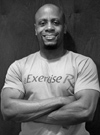Stretching: The Fitness Missing Link
By:
Are you often sore before and after a workout? Do you feel tight and stiff when not performing exercises? Do you have decreased range of motion while performing exercises? Do you cramp up before performing explosive or quick movements? Well, it’s about time you start to incorporate a stretching routine into your workouts.
Why should I stretch?
Stretching is one of the most underrated aspects of exercising, but in fact it is one of the main pillars of a healthy lifestyle. There are many benefits associated with stretching before and after a workout. Following a workout stretching helps elongate muscles that have been used in exercises that require contraction (the act of creating tension in the muscle fibers which shortens the muscle). Elongating muscles helps increase blood flow and aid in the recovery process. Stretching can help increase over all range of motion that is necessary to maintain proper form during exercises, which in turn will help decrease the risk of injury. Although stretching does not eliminate delayed onset muscle soreness (DOMS) – the customary soreness 24 to 72 hours after a strenuous workout – there are both anecdotal and evidential references that support a decrease in the discomfort associated with DOMS.
What types of stretches should I do?
There are a number of recognized stretching styles that can be performed, but for the purpose of this article we will cover the 3 most effective and practical forms of stretching.
Static Stretching is the most common type of stretching because it can be done anytime, anywhere and by anyone regardless of physiological knowledge or expertise. Static stretching usually consists of elongating a muscle by bending a joint and holding that position for 30 seconds at a time, i.e. the “sit and reach.” Static stretching can also be performed with the help of a partner – also known as “Passive Stretching” because you are not doing any work during the stretch – that will help you hold the stretch past a point that you are not capable of achieving on your own.
Dynamic Stretching is a form of stretching that is performed alone and is basically stretching while moving. While performing this type of stretch you must move the muscles and associated joints to your current range of motion without holding the stretch and continue this movement before a state of over exertion or muscle fatigue. This type of stretching prepares the body for movement and in many cases the stretches are similar to the movements being performed during the actual activity. Some dynamic stretches are: the walking knee hugs, walking low lunges, straight leg march, and jogging butt kicks.
Proprioceptive Neuromuscular Facilitation (PNF) Stretching is the most technical of the stretching styles and should only be performed by a trained professional, because of the risk of injury if improperly administered. This style of stretching is conducted by having the person being stretched apply a contraction force, of the muscle being stretched, then on the therapists cue, the muscle is relaxed and the therapist then stretches that muscle. An increase in flexibility is noticed immediately following the stretching routine, over time marked range of motion increases can be gained. But the process is risky, because of the increased range of motion their is a greater risk of injury.
When should I stretch?
Depending on your activity there are a number of stretches that can be performed at different phases of your exercise routine. However, the rule of thumb is never stretch a cold muscle. The best way to illustrate this idea is to think of a frozen chicken wing – as the piece is manipulated the skin will tear away from the bone; compare this to a de-thawed chicken wing which is more easily manipulated.
Before exercising be sure to warm-up; during or immediately following the warm-up process incorporate some dynamic stretches into your routine. Dynamic stretches are great during a warm-up because they do not disrupt the movement phase, they keep the thermal temperature up and they bring the muscles through a gradual concentric and eccentric contraction phase that prepare them for strenuous movements associated with working out.
If your workout does not consist of lifting weights or performing explosive movements such as sprints or jumps, it would be suitable to perform static stretching on tight muscles during your exercise routine. However, individuals who are lifting weights or are performing explosive movements such as sprints or jumps, should be cautioned about static stretching in between exercise sets, because of what is commonly known as “muscle slack” – which is the weakening of the muscle that occurs immediately after a muscle has been stretched, although the muscle will retract to its original length and strength over time, immediate muscle contraction will be negatively affected after a bout of static stretching. Instead it may be more beneficial to perform a shortened dynamic stretching routine to help increase blood flow to muscles and help increase range of motion in the affected muscle grouping.
After exercising, static stretching or PNF stretching are great ways to complete a workout. As mentioned previously static stretching can be done with or without a partner, while PNF stretching should only be performed with a trained professional.
When should I start?
Start your stretching routine the next time you head to the gym, you will notice the benefits immediately. Make stretching a part of your workout routine, allow five to ten minutes before your workout to perform some dynamic stretches along with a good warm-up and allow another five to ten minutes after your workout to perform some static stretches to help elongate those tight and shortened muscle fibers. Optimize your time in the gym and stretch effectively to get the most out of your muscles for more effective workouts.


